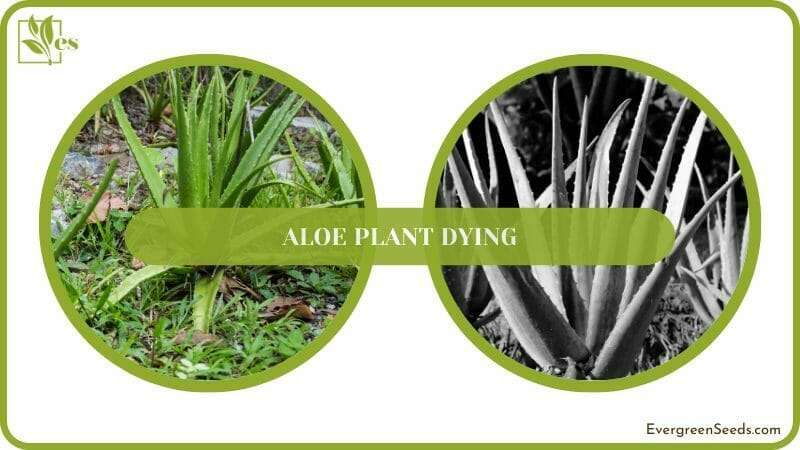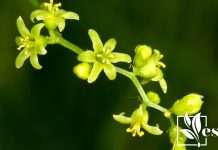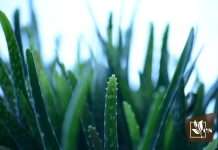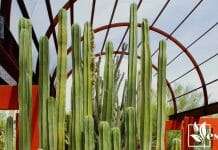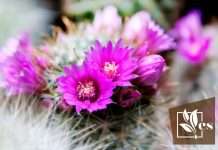You will find your aloe plant dying if you do not provide the right elements it requires. But don’t worry, it isn’t difficult to ensure your aloe vera remains healthy and in good shape.
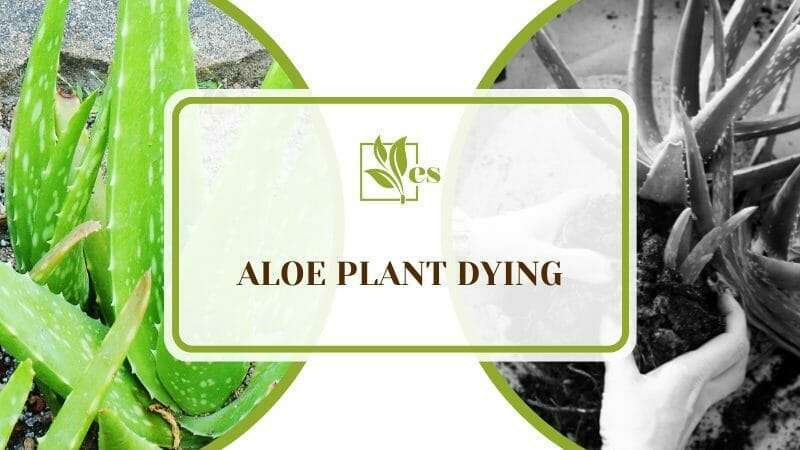
Read our expert tips and tricks to understand what you need to do to care for your gorgeous Aloe genus plant.
Why Is My Aloe Plant Dying?
Various reasons such as improper watering, incorrect temperatures, or even being placed in the wrong location can be the reason why your aloe plants may be dying. From your soil choice to the watering routine, a lot of things can go wrong. Here is a list of the most common reasons. The same approach can be used for plants that look like Aloe Vera if they have the same characteristics.
– Incorrect Watering Routine
Aloe plants are succulents. These kinds of plants can survive and thrive in dry conditions. They stay alive even in drought conditions.
Because of this, aloe plants do not require frequent watering. The right practice would be to drench them until the soil gets moist. Wait till the soil completely dries out before you water it again.
The number of times between watering will depend on the season. Summers will require more frequent watering with the soil drying out faster. Warmer rooms indoors will also lead to the soil drying out faster. Keep a close watch and water the plant accordingly.
– Soil Not Well-drained
Your soil should drain the water out well, so the container or pot must have holes big enough to allow the water to run out. If the holes get clogged, the roots of the plant will stand in water for long periods of time.
If the roots remain soggy, they will begin to rot and the plant will die. Do not water after a rainfall as the soil will already have enough water. Monitor the soil condition and wait until it dries out.
– Underwatering
If overwatering can kill your aloe plant, underwatering can slowly dry it out as well. Despite being able to thrive in drought conditions, the plant still requires some amount of water.
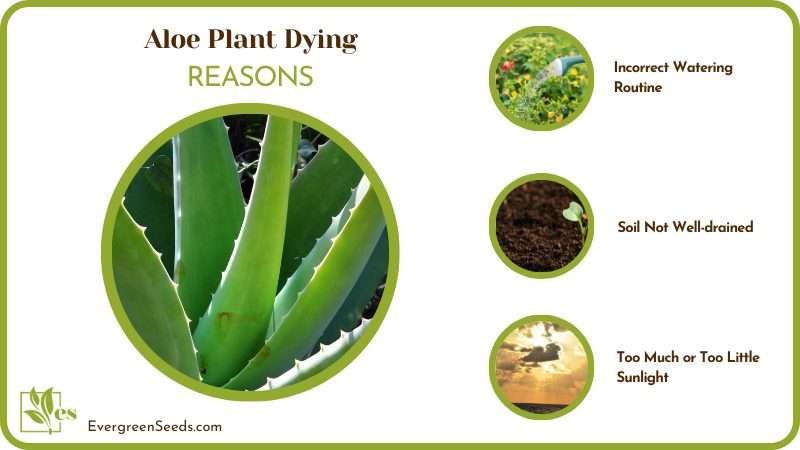
Look for signs of leaves turning brown or yellow. The leaves may also turn brittle and droop. These are signs that the plant requires water. Remember to keep the plant’s soil moist, not dry or soggy.
– Wrong Soil Choice
Aloe plants do not require rich potting soils. They need dry and sandy soil with gravel. Using rich potting mixes can kill the aloe plant.
You can also make a soil mix of silt, clay and soil to plant the aloe. Peat and perlite combinations along with mulch and organic manure can serve the plant well too.
– Too Much or Too Little Sunlight
Aloe plants can tolerate direct sunlight. The plant thrives well with 6 to 8 hours of sunlight every day, but excessive sunlight can cause stress conditions which can kill your plant. If your plant is out in the afternoon sun, have a shade screen to protect it from the harsh afternoon sun.
If your plant is indoors in a dark place, this condition can damage the plant as well. The succulent plants do not do well in shady and dark places. You will notice droopy, discolored leaves if your plant is left in this condition.
Ensure your plant is in a spot that receives enough sunlight and warmth. The right amount of sunlight is essential for the plant. Dark places also keep the soil damp, which will result in root rot and the death of your plant.
– Planted in an Incorrect Spot
If your aloe vera is under trees or large bushes, the plant can slowly die out. Aloe vera plants thrive in bright sunshine, so trees and bushes can block the sun out. Move the plant out to a sunny spot in your yard or garden.
– Incorrect Temperature
Aloe plants thrive in warm temperature conditions. They are also sensitive to variations in temperature, so going from hot environments to suddenly cold ones can kill them.
The leaves will turn brown when the temperature is too cold. At the same time, the leaves will get sunburnt and turn brittle when the temperature is too hot for the plant. Ensure the plants are at a temperature between 60 to 80 degrees Fahrenheit.
If there are temperature dips during the night, protect your plants with a blanket to keep them warm. You can also move them indoors if they are in a pot during the winter.
– Excessive Humidity
Aloe plants require less humidity than other plants. Being succulents, they retain moisture to survive in dry conditions. Excessive humidity provides the plant with a damp condition in which it cannot thrive.
Aloe plants in humid spaces indoors will require dehumidification. This will reduce the dampness around them as high humidity can slowly kill the aloe plant.
– Incorrect Pot Size
Check to see if your aloe plant is in a container that is too small for it. As the aloe plant grows bigger, its roots will spread, seeking more space and nutrition. Packing them in a small container will not be good for them.
Transplant your aloe plant into a bigger container when you notice that it has grown. The leaves will be a perfect indicator that it is time to do so. If the leaves are the same size or bigger than the container, it is time to move them to a bigger pot.
You can also slowly lift the plant from the base of the stem. If you notice a tight mass of roots that are difficult to untangle, it is time to move your plant to another container.
– Pest Infestations
A droopy and lifeless aloe plant can have pest infestations. These pests suck the sap out of the thick stems to make them limp. The sap of the aloe plant is its nutrients, and without it, they eventually die.
Look for pests or eggs on leaves. As pests begin to die on the leaves, you will find tiny brown spots all over.
Snout beetle is a popular pest on the aloe plant that punctures the leaves. Any such large infestation can weaken the plant and kill it, so remove pests as soon as you spot them.
How To Revive
If you find your aloe plant droopy and lifeless, you can revive it through several methods such as fixing your watering schedule, using rooting powder and changing the container, among others.
Here is what you need to do to bring an aloe plant back to life.
– Tackling an Overwatered Plant
If you have accidentally overwatered your aloe plant, don’t worry as you can still save it from waterlogging at the roots. Dig up the soil and let it dry out for a few days.
To save a dying aloe vera plant, remove any leaves or roots that seem to be mushy. Airing the soil around the plant will also help remove the excess water around it.
– Use Rooting Powder
Another way to tackle an overwatered aloe plant is to dust the base of the plant with rooting powder. After this, replant it in a container with a proper drainage hole. In a couple of days, you should be able to see the plant reviving and growing healthy leaves.
– Change the Container
Choose a container with big drainage holes at the base. Aloe plants need a pot with well-draining holes. Ensure the drainage holes are big enough to let the water run out to prevent root rot due to waterlogging.
A bigger container will work towards keeping the roots healthy.
– Provide the Right Amount of Sunlight
Aloe plants in the shade tend to get droopy, so provide them with a minimum of 4 to 6 hours of direct sunlight a day. Move them to a sunny spot in your yard.
When moving them to the sun, do it gradually. The plants can’t handle sudden shock or changes in temperature. Gradually expose them to the required sun; do not move your aloe plant from shade to intense sun in a day.
Help them acclimatize by moving the pot back and forth for shorter durations in the sun over a week or two. This will give the plant time to adjust to the sunlight.
– Scale Back on Watering
Even during the summer seasons, aloe plants do not require frequent watering. Water aloe plants only when the soil has completely dried out. This could vary anywhere from once a week to a fortnight, depending on the weather and temperature in your area.
– Transplant It Properly
Prepare a plant container that is double the size of the plant. Check to see that the pot has holes that drain the water well. With the help of a sharp knife, remove the plant from the small pot. Replant and water to keep the soil moist.
Taking Care of a Dying Aloe Plant
You can save an aloe plant and make it healthy. Here is what you need to do to take care of a dying aloe plant.
– Indoor Aloe Plant Care
If you have your plant indoors, place it in indirect yet bright sunlight, ideally near a window on the south or west side of your house. If you are growing your plant indoors, keep it away from air conditioners, which can blast it with constant cold air.
– Tackle Pests
Spray the aloe plant with an alcohol-based solution. This will help in killing the pests on the plant. For snout beetles, sprinkle some insecticide powder.
Fungus gnats are best removed by drying out the soil. These bugs thrive in damp conditions, so moving the plant gradually into the sun will help.
– Flush the Soil
Another way to save your aloe plant is to flush the soil thoroughly. Place your aloe plant in your sink or any gentle water source and drench the soil.
Let all the extra water drain out of the pot. This will help wash away the fertilizer build-up in the soil. Leave the plant to dry its soil completely.
– Avoid Excessive Fertilizers
Do not over-fertilize your aloe plant. They don’t need it. If your potting soil came with fertilizer mixed in, then avoid adding anything more. Otherwise, you can fertilize the plant once a year during spring.
– Prevent Fungal Diseases
Aloe plants can be subject to fungal diseases. The common reason for this is overwatering. If you spot fungal spots on leaves, prune away the diseased leaves and reduce the watering, letting the soil dry out first.
Prevent further diseases by watering your plant correctly. Also, water the plant during the morning hours to give enough time throughout the day for the water to evaporate.
Use antifungals to get rid of fungal or bacterial diseases.
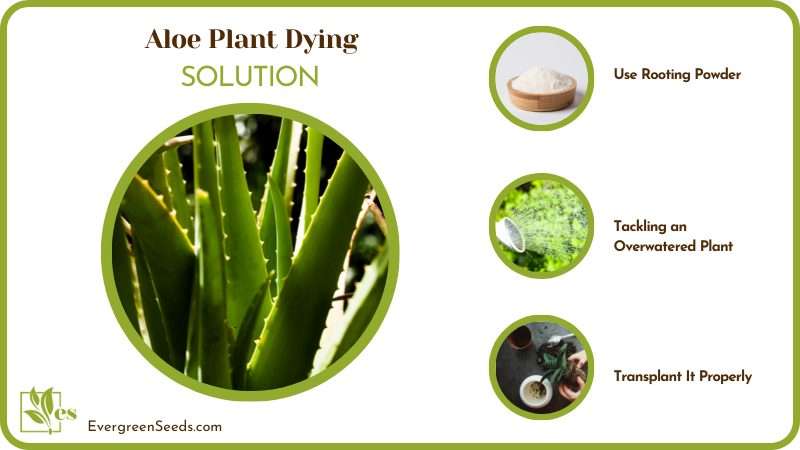
– Keep the Plant Comfortable
Monitor the plant temperature and moisture conditions. Temperatures that are too cold or too hot lead to shock, which can kill your plant. Maintain the temperature at 55 to 80 degrees Fahrenheit and the humidity needs to be at a level of 40 percent.
– Prevent Aloe Sunburn
Aloe plants are sensitive to excessive heat. Direct sunlight with excessive heat can cause sunburn. You will need to keep the plant in bright, indirect light to prevent this issue.
Water the plant more often during the summer months compared to the winter seasons, but make sure you check the soil first.
– Weed Out Dead Leaves
Dead leaves can draw nutrition from the healthy parts of the plant. These leaves can also infect the plant if they are diseased with fungi or bacteria.
Remove any dead leaves as soon as you spot them. This will protect the other healthy sections of the plant.
Cutting leaves also encourage thicker growth of the aloe plant. It will aid the plant to store nutrition, resulting in healthy aloe roots.
– Choose Terracotta Over Plastic
If your aloe plant is in a pot, choose terracotta pots over other materials. These pots are porous, thus allowing the soil to dry out quickly.
Avoid plastic containers as plastic does not breathe. It traps the moisture within it, leading to an increase in the humidity factor for the plant. On the other hand, terracotta pots allow the moisture to evaporate and make the water drain faster.
